Darby Beach
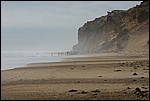 db1.jpg |
Welcome to Darby Beach. The beach has some spectacular cliffs, up to about 50 m high, that are fascinating in a regolith geology sense, as well as being plain spectacular to look at. This view looks north from where the walking track from the car park emerges onto the beach. |
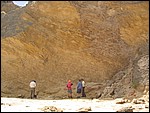 db2.jpg |
The cliffs at Darby Beach are composed of thinly-bedded calcarenite, a soft sedimentary rock composed of sand-sized calcareous shell fragments and minor quartz sand. The calcarenite was deposited as calcareous sand dunes during a glacial maximum period some time in the last 150,000 years, when the sea level was much lower than today. How do we know these were ancient sand dunes? There are several lines of evidence, including steeply-dipping bed foresets (seen here). Foresets lie at an angle of repose that is greater than that allowable in fluvial sediments, so the sediments must be aeolian. |
 db3.jpg |
A close-up view of the calcarenite bed foresets. Another important piece of evidence that these deposits formed in ancient sand dunes is the presence of root tubules, now totally replaced by calcrete. Shown here, bed foresets dip inwards to the top right. The vertical tubes are the remains of roots, belonging to trees that once grew through the dune tops above, and perhaps vertical burrows. |
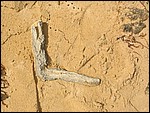 db4.jpg |
Occasionally the preserved root tubules fall out of the cliff face. This example is a cast of a bent tree root. |
 db5.jpg |
Another important piece of evidence for the sand dune interpretation is the presence of several paleosol (ancient soil) layers within the sequence. These often cross-cut bedding (as do modern soils) and can also preserve the dune swales (the low valleys between dune crests). This image shows a paleosol cutting across the bedding in dune foresets. The paleosol is a massive red-coloured layer that grades downwards into a bleached (white) layer. Numerous large tree roots and stumps, now totally replaced by calcrete, occur in the base of the paleosol, occasionally penetrating upwards through it. The upper dune foresets conform to the top of the paleosol, signifying a new generation of dune building parallel to the soil surface. |
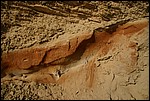 db6.jpg |
Seen in close-up, the paleosol is red-coloured at its top, merging into bleached paleosol at its base. The paleosol is more clay-rich than over- and under-lying calcarenite and is also heavily bioturbated, giving it a structureless texture. It is common to see small root tubules and insect or worm burrows in the paleosols. |
 db7.jpg |
The top of the calcarenite dune sequence is covered by more modern white quartz sand dunes. In this photo a small outcrop of the calcarenite dune sequence lies in the foreground showing well-developed bedding. Above this, in the background, you can see the top-most, chocolate-coloured paleosol overtopped by white quartz sand with vegetation growing in it. |
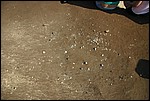 db8.jpg |
The local aboriginal people carried their catches up into the dunes to seek shelter from the wind, or just to get a better view. Here the remains of a midden, or shell pile, is seen mixed with small fragments of charcoal in partially consolidated clayey sand, part of the uppermost paleosol at Darby Beach. The middens are reputed to be at least 6,000 years old, indicating that this paleosol is potentially that old. |
 db9.jpg |
The aboriginals who inhabited this area had an eye for detail. Here's a small collection of clear quartz crystals which the students found lying around in the midden. Quartz is ideal for making small sharp cutting tools, so it was carried and traded for other items far and wide. If you look closely you can see that several of the crystals have been shaped; they have multiple long thin conchoidal fracture planes indicating that they have been carefully worked to knock off thin sharp blades. |
You can learn more about Darby Beach by reading: W.D. Birch ed. 2003. Geology of Victoria. Geological society of Australia special publication No. 23. 842 p. |
|